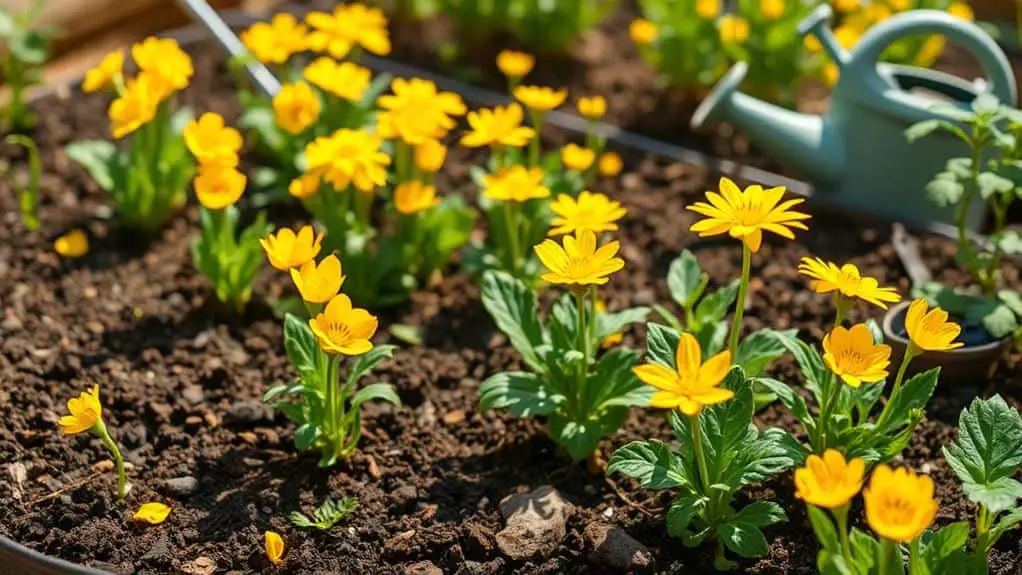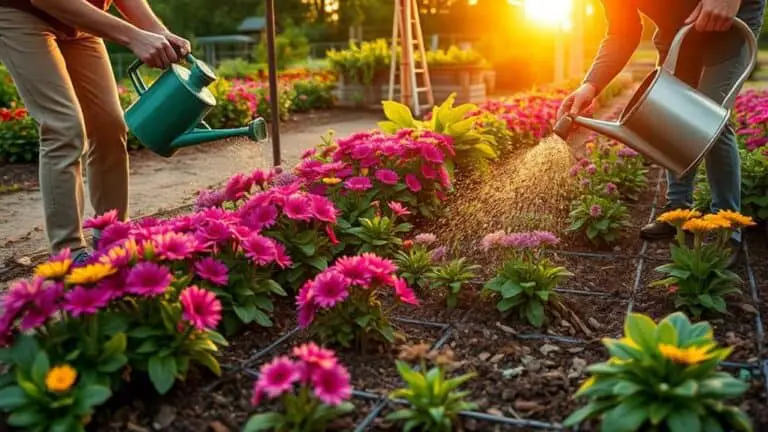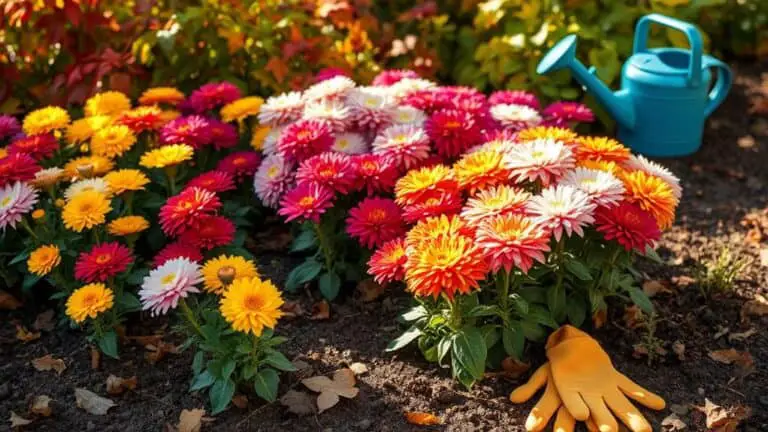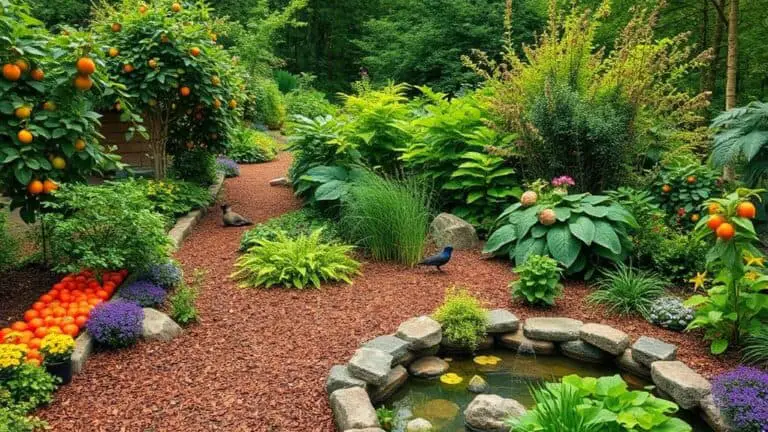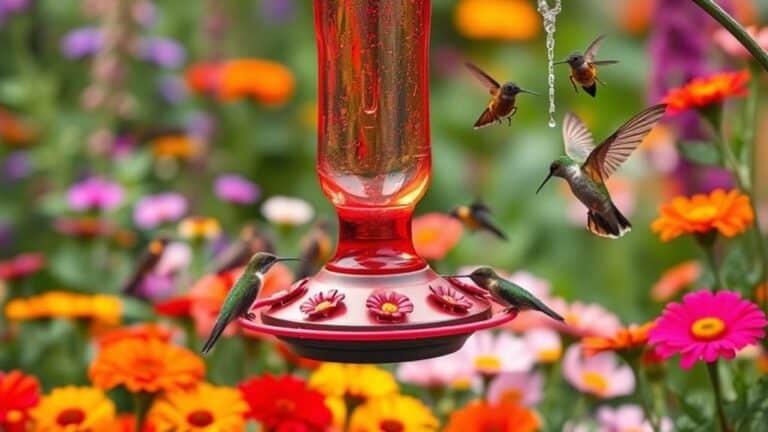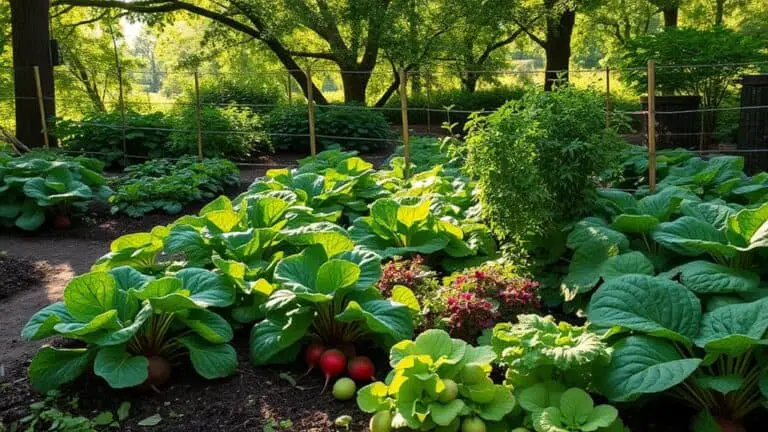How To Plant Grow And Care For Primrose Flowers
When I first started planting primrose flowers, I quickly learned that their vibrant blooms can truly brighten up a garden. But, it's not just about planting them anywhere; they thrive best in well-draining soil and partial shade. Consistent watering and the right type of fertilizer are also vital. Have you ever wondered how to guarantee they bloom beautifully each spring or how to keep pests at bay? Let's explore some essential tips and techniques that will help you nurture these lovely flowers to their full potential.
Overview of Primrose Flowers
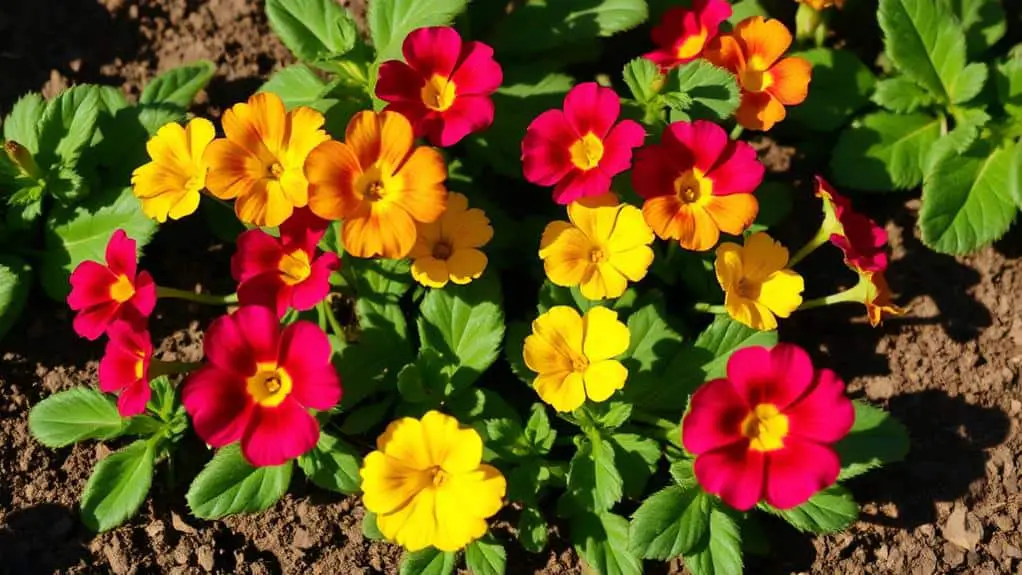
Primrose flowers, scientifically known as Primula, are short-lived perennials that come in a stunning variety of colors, such as yellow, red, pink, white, purple, orange, and even blue.
These vibrant flowers typically bloom in early spring, from April to May, and can last several weeks. They're perfect for attracting bees and butterflies to your garden.
To guarantee successful growing, plant primroses in rich, well-draining soil and place them in partial shade. They thrive best in USDA zones 5 to 7.
Proper care includes keeping the soil moist but not waterlogged and providing some protection from the hot afternoon sun.
With the right conditions, you'll enjoy a beautiful display of primrose flowers in your garden.
Benefits and Uses
Understanding how to care for primrose flowers sets the stage for appreciating their numerous benefits and uses in your garden. These low-maintenance perennials add color with their vibrant pink, red, yellow, and purple blooms. They thrive in well-drained soil and a moist environment, making them perfect for beginners. Primrose flowers are pollinator-friendly plants that attract bees, butterflies, and beneficial insects, enhancing your garden's biodiversity. Their versatility means they can be used in borders, woodland gardens, rock gardens, and container displays. Plus, they act as a deterrent for pests like deer and rabbits.
Here's a quick look at their benefits:
| Benefit | Details |
|---|---|
| Adds color | Vibrant pink, red, yellow, and purple |
| Low-maintenance perennials | Suitable for beginners |
| Pollinator-friendly | Attract bees, butterflies, insects |
| Deterrent for pests | Avoided by deer and rabbits |
Ideal Planting Locations
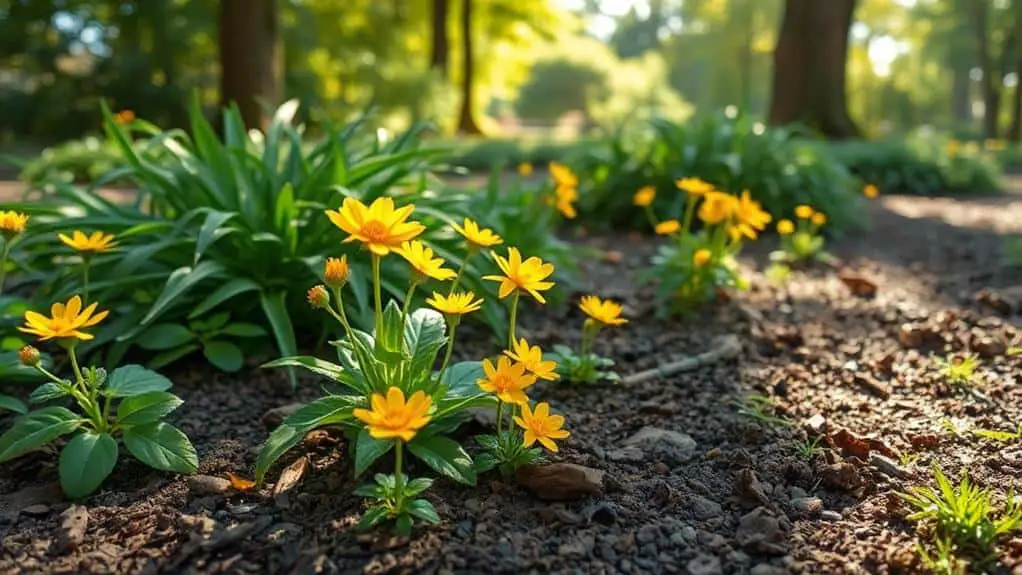
Finding the perfect spot for planting primrose flowers can make all the difference in their growth and vibrancy.
Primroses thrive in well-draining soil enriched with organic matter, which helps keep the soil moist but not soggy, preventing root rot. Ideal planting locations include borders, rock gardens, and containers, fitting seamlessly into various garden designs.
They do best in partial shade but can also adapt to full sun or full shade. For a stunning effect, consider underplanting primroses beneath taller perennials or shrubs. This not only enhances your garden's visual appeal but also provides the dappled light and moisture they love.
Woodland gardens are also fantastic, offering natural complement and suitable light and moisture conditions.
Soil and Sunlight Requirements
To help your primroses thrive, you'll want to plant them in well-draining, rich soil that's slightly acidic to neutral, with a pH between 6.0 and 7.0.
They do best in partial shade, but some types can handle full sun or full shade if needed.
Just make sure the soil is loose and full of organic matter, and keep an eye on the sunlight to avoid scorching their leaves.
Ideal Soil Conditions
Caring for primroses starts with ensuring they've the right soil and sunlight conditions.
These plants thrive in well-draining soil that's rich in organic matter, like compost. The ideal soil should be slightly acidic to neutral, with a pH between 6.0 and 7.0.
Keep the soil evenly moist but not waterlogged; too much water can cause root rot. Preparing the soil a few weeks before planting helps nutrients settle, giving your primroses the best start.
Adding a layer of compost or leaves as mulch helps retain moisture and suppress weeds. With these soil conditions, your primroses will flourish.
Optimal Light Exposure
Providing the right light exposure is essential for primroses to flourish.
Primrose plants thrive in partial shade, though some varieties can handle full sun or full shade. For ideal growth, they need well-draining soil that's rich in organic matter and kept evenly moist.
In indoor settings, place your primroses where they get bright indirect sunlight, like near a south-facing window, but avoid direct sun to prevent leaf scorching.
Watering and Fertilizing
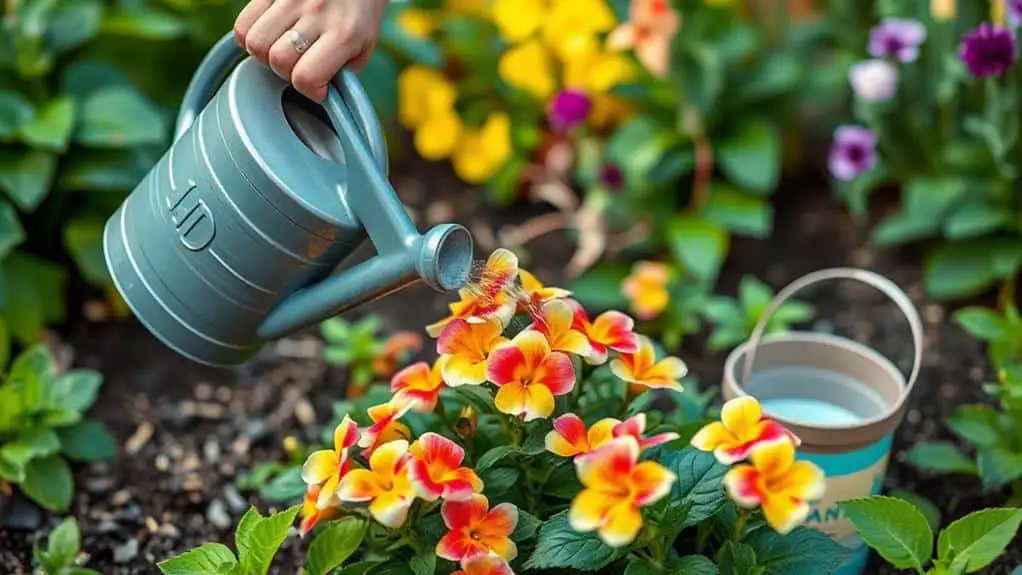
Watering and fertilizing primrose flowers are essential steps to guarantee they thrive. To keep the soil consistently moist, make sure to water when the top inch feels dry.
Good drainage is vital to avoid crown rot, so don't let water pool around the roots. During the growing season, use a balanced fertilizer once or twice in early spring and fall to promote healthy growth.
Mulching with 3-4 inches of organic material helps retain moisture and suppress weeds. For potted primroses, regular watering is key, and maintaining moist soil is important.
A pebble tray or humidifier can help increase humidity around indoor plants. With these tips, your primroses will flourish beautifully.
Regular Maintenance Practices
To keep your primroses looking their best, regular maintenance is key. First, make certain to regularly deadhead spent blooms. This simple task encourages new flower growth and prolongs the blooming period.
Next, apply a layer of mulch around the plants. Mulch helps conserve moisture, suppress weeds, and regulate soil temperature.
When you water primroses, check that the top inch of soil is dry first. They thrive in evenly moist but well-draining soil.
Fertilize primroses once or twice annually in spring and fall to support healthy growth and flowering.
Keep an eye out for pests and diseases, addressing any issues promptly.
These regular maintenance practices will support plant health and guarantee your primroses remain vibrant and beautiful.
Propagation Techniques
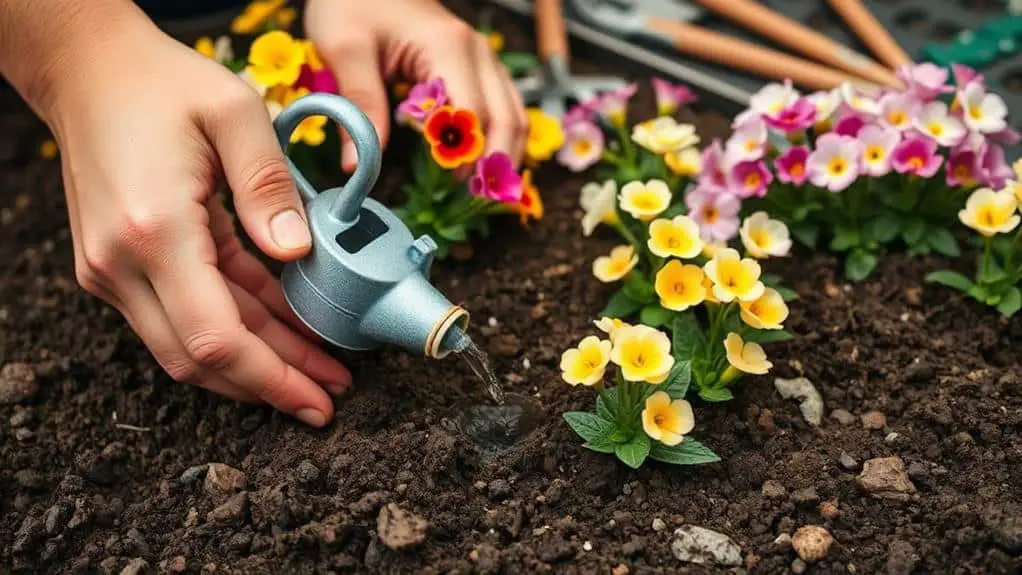
When it comes to propagating primroses, there are a few reliable techniques to contemplate.
First, consider division. You can lift and separate established clumps in the fall or early spring. Confirm each division has roots and enough foliage before replanting.
Next, try seed sowing. Sow the seeds indoors in late winter or outdoors in the fall. They need cool temperatures, around 40-50°F, for successful germination.
Another method is leaf cuttings. Cut healthy leaves into sections and plant them in potting mix. Keep the cuttings moist to encourage new plant growth.
Regardless of the method, moisture maintenance is essential. Newly propagated plants must stay consistently moist until they're well-established.
Timing is important, so propagate after flowering.
Companion Planting Ideas
Pairing primroses with suitable companions can elevate the beauty and health of your garden.
Hostas are fantastic companion plants, offering a lush, green backdrop that thrives in the same shade and moist conditions as primroses. Ferns are another excellent choice, providing a striking green contrast and also loving the shade.
For a pop of color, Bleeding Hearts with their delicate pink flowers look stunning next to primroses. Adding Heuchera, or Coral Bells, can enhance the color variety in your garden, as both plants enjoy similar soil conditions.
Pest Management

Let's talk about keeping your primroses healthy by managing pests and diseases.
To handle common pests like slugs, snails, spider mites, and aphids, you'll need to avoid overwatering, clear away debris, and use insecticidal soap or neem oil.
For disease control, make certain your plants have good air circulation, monitor soil moisture, and plant them in well-draining soil.
Common Primrose Pests
Caring for primrose flowers means being vigilant about common pests that can wreak havoc on their delicate foliage.
Here are some tips to help you manage these pests effectively:
- Slugs and Snails: Hand-pick these pests or use diatomaceous earth as a barrier to keep them away.
- Spider Mites: These thrive in hot, dry conditions. Regularly mist and wash the leaves to prevent infestations.
- Aphids: Control these sap-suckers with insecticidal soap or neem oil without harming beneficial insects.
- Whiteflies: Guarantee proper drainage and good air circulation to minimize the risk of these pests.
Effective Disease Control
Maintaining primrose flowers' health requires vigilant disease control to keep them flourishing. Regularly inspect your plants for common pests like slugs, snails, spider mites, and aphids. Early detection helps manage these pests effectively.
Hand-picking slugs and snails or using diatomaceous earth barriers are non-toxic methods that protect beneficial insects. Maintain good air circulation around your primroses to prevent fungal disease.
Avoid overwatering to keep the soil moist but not waterlogged, as this can cause crown and root rot. Proper watering practices are essential.
For outbreaks of aphids and spider mites, try insecticidal soap or neem oil, which are both environmentally friendly.
Disease Control
When it comes to disease control for primrose flowers, effective management hinges upon early detection and proactive measures.
Here's what I've found most helpful:
- Leaf Spot: Remove infected leaves promptly and guarantee good air circulation to prevent this disease.
- Powdery Mildew: Regularly inspect your plants and avoid overcrowding to improve air circulation.
- Overwatering: Prevent crown rot by using well-draining soil and watering appropriately.
- Aphid Infestations: Use neem oil or insecticidal soap to manage these pests and prevent leaf distortion.
Maintaining healthy soil practices, like crop rotation, reduces soil-borne diseases.
Keep an eye on your plants, and you'll be able to enjoy vibrant primroses with fewer issues.
Happy gardening!
Frequently Asked Questions
How Do You Keep Primroses Blooming All Summer?
To keep primroses blooming all summer, I deadhead spent flowers, use summer fertilization, and follow precise watering techniques. Primrose varieties need partial shade, proper soil preferences, pest control, and companion plants. Seasonal care guarantees sustained beauty.
Where Is the Best Place to Plant Primroses?
I plant primroses in partial to full shade to avoid harsh sunlight exposure. I choose well-draining soil enriched with organic matter, ensuring proper spacing for airflow. They thrive in cool temperatures with consistent watering, making them excellent companions in woodland gardens.
Does Primrose Come Back Every Year?
Yes, primrose comes back every year if you care for it well. Make certain you choose hardy primrose varieties, provide the right primrose soil, sunlight, and watering, and manage primrose pests. Proper primrose spacing and fertilizers also help.
What to Do With Primroses After Flowering?
After flowering, I deadhead spent blooms and apply post-bloom fertilization. I manage pests and adjust watering schedules. In late spring, I divide primrose clumps, using companion planting options. For winter, I use protection strategies.
Conclusion
I hope you feel ready to plant and care for your primrose flowers! Remember, choose a spot with rich, well-draining soil and some shade. Keep the soil moist, but don't let it get soggy. Regularly deadhead the flowers and mulch to keep moisture in. With a little attention to pests and diseases, you'll have beautiful blooms in early spring. You've got this! Happy gardening, and enjoy the vibrant colors and joy your primroses will bring.

